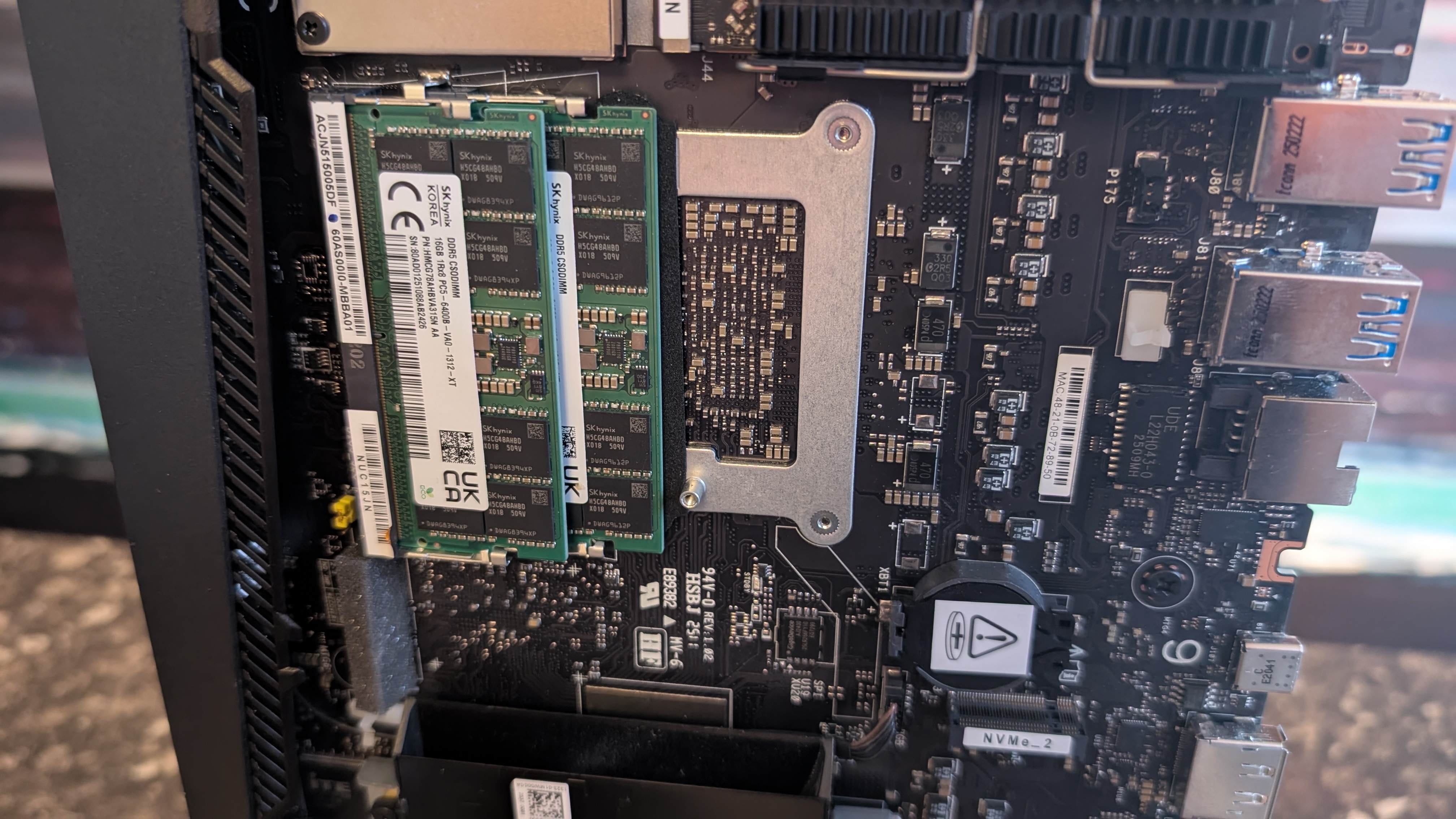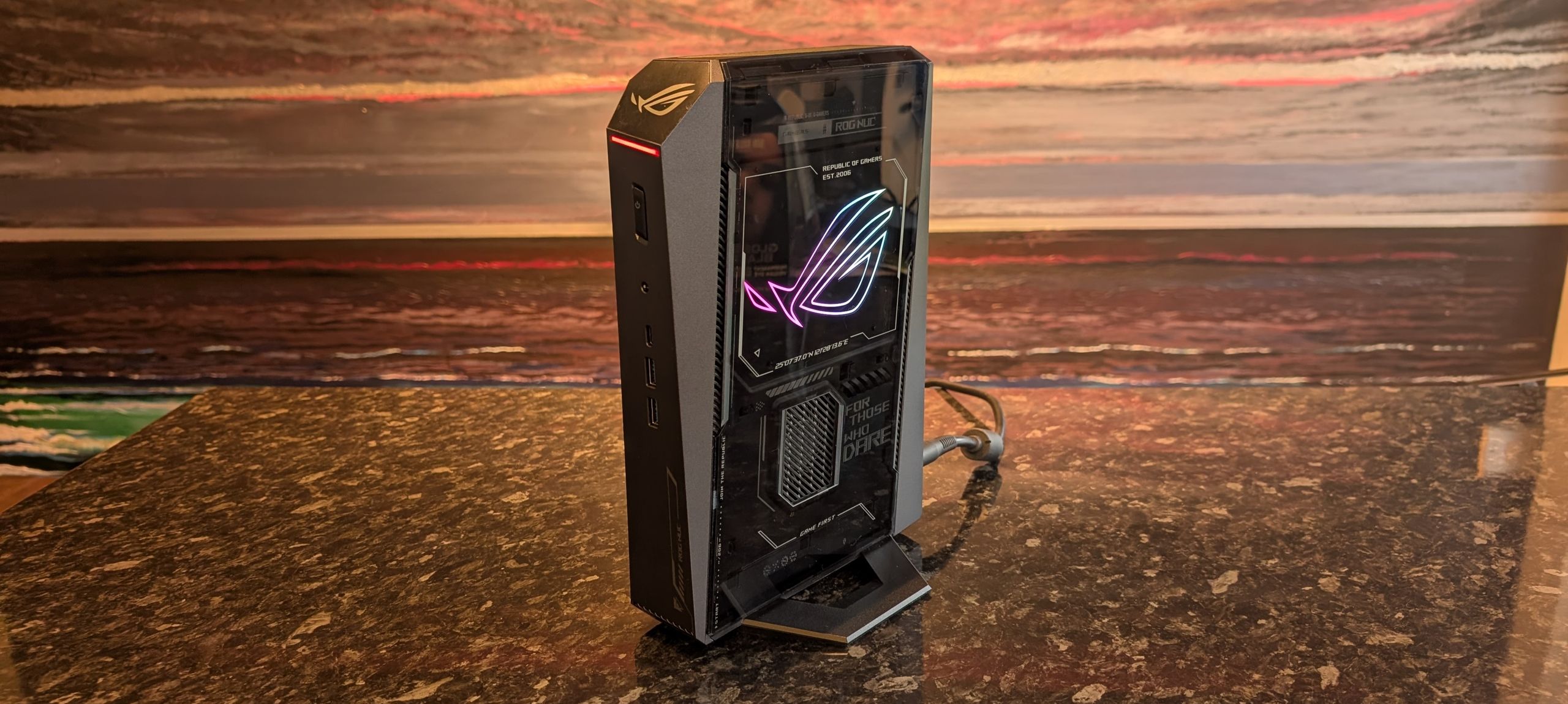Why you can trust TechRadar
We spend hours testing every product or service we review, so you can be sure you’re buying the best. Find out more about how we test.
Asus ROG NUC (2025): Two-minute review
I’ll start this review off by simply saying this: the Asus ROG NUC absolutely belongs on our list of the best mini PCs, and perhaps indeed the best computers overall – expect to see it make an appearance on those pages in the near future.
Asus has been hard at work on the NUC series, which was originally conceived by Intel as a new breed of compact desktop PCs before being sold off to Asus in 2023; amidst Intel’s multitude of troubles at the time, it was deemed a necessary move to streamline the company and focus on chipmaking rather than PC production. The NUCs were historically pretty good devices, but it’s clear that Asus has taken them to an entirely new level.
The new-for-2025 ROG NUC is a wonder; an ultra-compact desktop system packed with some of the most powerful cutting-edge gaming components, including a 2nd-gen Intel Core Ultra processor and an Nvidia GeForce RTX 5000 GPU (the one in my review unit is an RTX 5080), plus 32GB of RAM and a 2TB SSD.
The whole system is essentially constructed around that graphics card, which is technically a laptop GPU – one can only assume that a full-scale desktop 5080 would be too chunky, even though Nvidia worked hard to scale down the comically gigantic cards of the RTX 3000 and 4000 eras. As you might expect, performance is excellent; expect high framerates and smooth gameplay at 1440p and even 4K, though the sorry state of modern PC game optimization means you’ll probably need to turn on DLSS in some titles at 4K.
Those powerful components mean the ROG NUC is also a competent workstation system, which could prove to be a boon for professional creatives who need a powerful PC but have limited desk real estate to work with (and don’t want to jump ship to macOS with the admittedly excellent M1 Mac mini).
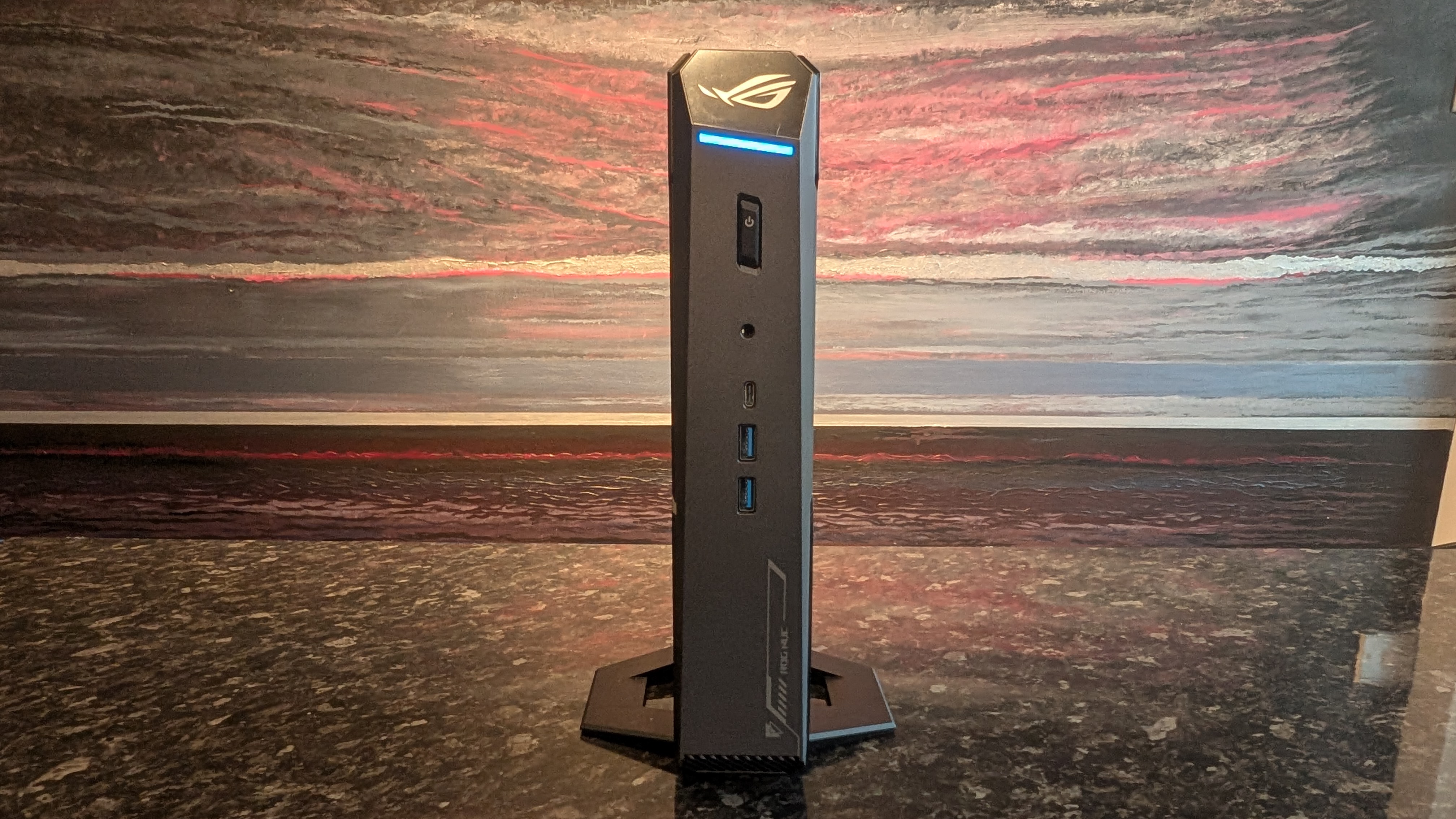
Asus ROG NUC (2025) review: Price & Availability
- Starts from $2,599 / £2,129 / AU$4,499
- Available now in the US, UK and Australia
- Both RTX 5070 Ti and 5080 models available
Starting at $2,599 / £2,129 / AU$4,499 for the base configuration, which sports an RTX 5070 Ti rather than the 5080 in my review unit, along with less storage and RAM as you can see in the spec table, the new ROG NUC isn’t exactly what I’d call affordable. Meanwhile, the 5080 model featured in this review – which is externally identical – will run you a hefty $3,199 / £2,599 (around $4,925).
Still, it’s not absurdly priced for what it offers; considering the sheer lack of powerful compact PCs on the market, the best option for many potential users will be to build your own ITX system, and having spent plenty of time mucking about with compact PC cases in my years as a computer hardware journalist, I can say with certainty that it’ll be a lot harder than simply buying a ROG NUC. Oh, and it most likely won’t be as small, and will potentially end up being more expensive too!
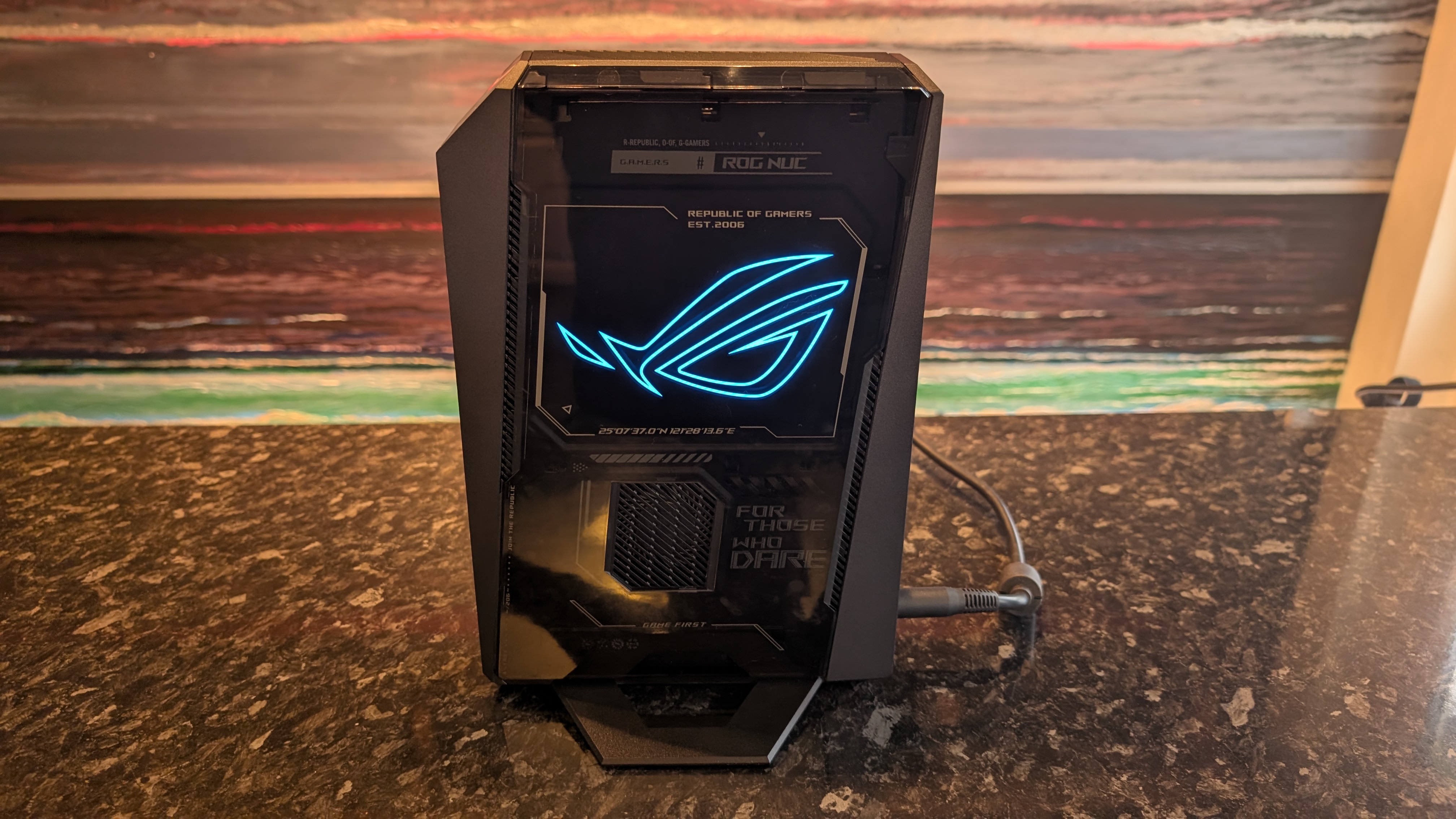
So while the NUC is undeniably a pretty expensive piece of kit, I can’t mark it down too much for that; if a powerful but ultra-compact PC for serious gaming or content creation work is what you want, this might be the single best option out there right now. Of course, a PS5 Pro will cost you a lot less… but it also doesn’t fill the role of a fully capable desktop PC.
The Asus ROG NUC (2025) is already available to purchase direct from Asus and partner retailers in the US, UK and Australia.
Asus ROG NUC (2025) review: Specs
Asus ROG NUC (2025) Intel Specs
| Attributes | Base Config | Review Config |
|
Price |
$2,599 / £2,129 / AU$4,499 |
$3,199 / £2,599 / AU$5,899 |
|
CPU |
Intel Core i5-13420H (8 cores, 2.10GHz) |
Intel Core Ultra 9 275HX (2.70GHz) |
|
GPU |
Nvidia GeForce RTX 5070 Ti 16GB Laptop GPU |
Nvidia GeForce RTX 5080 16GB Laptop GPU |
|
RAM |
16GB DDR5 |
32GB DDR5 |
|
Storage |
1TB PCIe NVMe 4.0 M.2 SSD |
2TB PCIe NVMe 4.0 M.2 SSD |
|
Ports and Connectivity |
6x USB-A 3.2 Gen 1, 2x USB-C 3.2 Gen 2 (Thunderbolt 4), 2x HDMI 2.1, 2x DisplayPort 2.1, 1x RJ-45, 1x 3.5mm combi audio jack, Kensington Lock |
6x USB-A 3.2 Gen 1, 2x USB-C 3.2 Gen 2 (Thunderbolt 4), 2x HDMI 2.1, 2x DisplayPort 2.1, 1x RJ-45, 1x 3.5mm combi audio jack, Kensington Lock |
|
Dimensions |
11.1 x 7.4 x 2.2in / 28.2cm x 18.8cm x 5.7cm |
11.1 x 7.4 x 2.2in / 28.2cm x 18.8cm x 5.7cm |
|
Weight |
6.79lbs / 3.12kg |
6.79lbs / 3.12kg |
Asus ROG NUC (2025) review: Design
- Amazingly compact design
- Surprisingly good amount of ports
- Limited upgrade potential for a desktop PC
Making a compact PC chassis can take designers in a lot of different directions. Do you aim for a low, flat design like Apple’s Mac mini, or build upwards with a small footprint like the fantastic Corsair One i500?
As you can no doubt tell from the pictures, Asus has gone for the latter approach, with a thin tower design that produces a footprint of less than eight-by-six inches (full dimensions in the spec sheet above). It can technically also be laid on its side with the stand removed – ideal for putting it in a TV stand as a console-style living room PC – but after disassembling it, I can say that I wouldn’t particularly recommend that unless you’re willing to prop it up on something to ensure that the exhaust fans have enough breathing room to vent properly.
Speaking of disassembly: I don’t always dig around in the guts of pre-built systems, but this was one case where I felt obliged to. See, the NUC series (standing for ‘Next Unit of Computing’) was originally founded by Intel in 2013 with the goal of creating a small-form-factor barebones PC with customization and upgrade potential.
Asus has clearly moved away from this ethos somewhat, as the ROG NUC is not only a fully-fledged system, but also has relatively little upgradability.
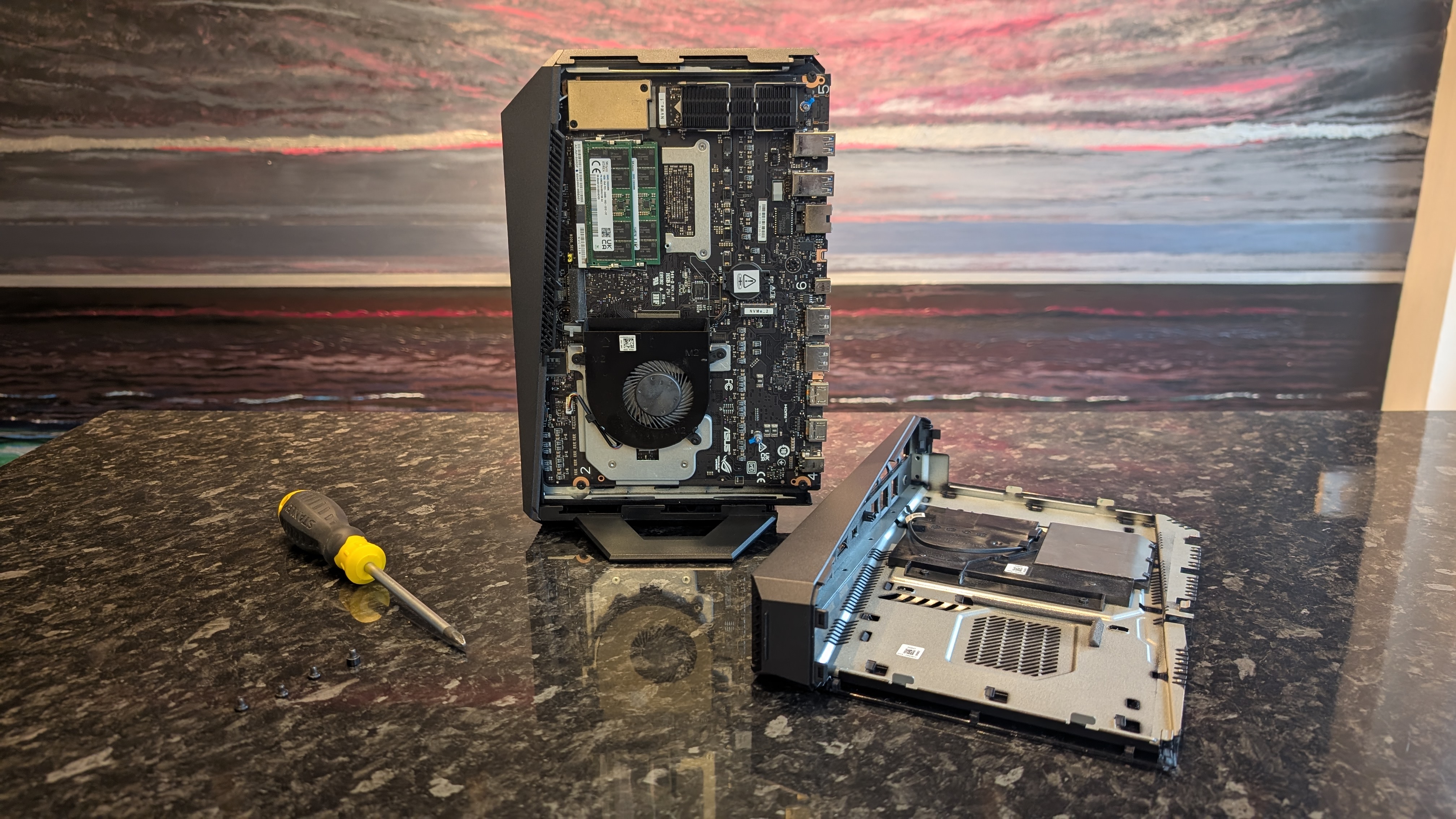
Upgrade options here are effectively limited to the RAM and SSD, and you’ll need to discard the old RAM if you want more, since there are only two DIMM slots and they’re both already occupied. There is, however, a spare M.2 slot for fitting a second SSD, should you want to expand your storage.
Really, this level of upgradability might be a slight step down from the more classic barebones NUCs Intel used to make, but it’s pretty par for the course as far as modern mini PCs go.
The case is also easy enough to open up for any upgrade work, which is nice to see; I’ve dealt with mini PC cases that seemed determined not to let me get at the goodies inside.
Thermal management is handled by multiple fans, with vents on both flat sides and the top. It’s quite effective at keeping the whole unit cool (even at the peak of my benchmarking process, the ROG NUC didn’t get particularly warm to the touch), although I would note that the fans can get rather loud when running resource-intensive games; if you’re planning to play in 4K, I’d recommend a headset or one of the best computer speakers.
Overall, I like the design; it’s a bit less visually busy than last year’s model, while still managing to fit in a good range of physical ports for connecting your devices. In addition to two HDMI and DisplayPort video outputs for connecting multiple monitors, you also get two Thunderbolt USB-C ports, six USB-A ports, an RJ-45 Ethernet slot, and the good ol’ 3.5mm headphone jack. As mini PCs go, this NUC has it all.
Asus ROG NUC (2025) review: Performance
